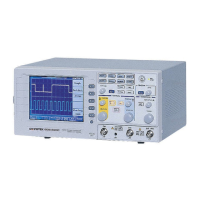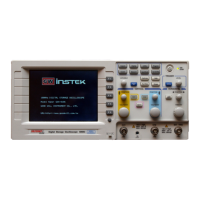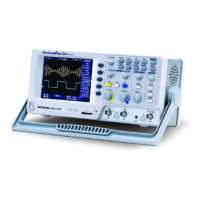GDS-806/810/820/840 Programming Manual
76
Use serial poll or the *STB? Query to read the contents of the SBR. The bits in the
SBR are set and cleared depending on the contents of the Standard Event Status
Register (SESR), the Standard Event Status Register (SESR), and the Output
Queue.
Standard Event Status Register (SESR): Table 5-4 shows the SESR
Bit 7 Bit 6 Bit 5 Bit 4 Bit 3 Bit 2 Bit 1 Bit 0
PON USR CME EXE DDE QYE NU OPC
128 64 32 16 8 4 2 1
Table 5-4: Standard Event Status Register (SESR)
The bit 0 (OPC, Operation Complete) shows that the operation is complete. This
bit is active when all pending operations are complete following an *OPC
command.
The bit 1 is always zero.
The bit 2 (QYE, Query Error) indicates a command or query protocol error. The bit
3 (DDE, Device Error) shows that a device error occurred.
The bit 4 (EXE, Execution Error) shows that an error occurred while the
oscilloscope was execution a command or query.
The bit 5 (CME, Command Error) shows that an error occurred while the
oscilloscope was paring a command or query.
The bit 6 (USR, User Request) is ignored here for this oscilloscope.
The bit 7 (PON, Power On) shows that the oscilloscope was powered on.
Use the *ESR? Query to read the SESR. Reading the SESR clears the bits of the
registers so that the register can accumulate information about new events.

